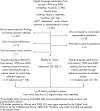Smoking cessation attempts among adolescent smokers: a systematic review of prevalence studies
- PMID: 18048598
- PMCID: PMC2807205
- DOI: 10.1136/tc.2006.018853
Smoking cessation attempts among adolescent smokers: a systematic review of prevalence studies
Abstract
Objective: To synthesise estimates of the prevalence of cessation attempts among adolescent smokers generally, and according to age and level of cigarette consumption.
Data sources: PubMed, ERIC, and PsychInfo databases and Internet searches of central data collection agencies.
Study selection: National population-based studies published in English between 1990 and 2005 reporting the prevalence, frequency and/or duration of cessation attempts among smokers aged >or=10 to <20 years.
Data extraction: Five reviewers determined inclusion criteria for full-text reports. One reviewer extracted data on the design, population characteristics and results from the reports.
Data synthesis: In total, 52 studies conformed to the inclusion criteria. The marked heterogeneity that characterised the study populations and survey questions precluded a meta-analysis. Among adolescent current smokers, the median 6-month, 12-month and lifetime cessation attempt prevalence was 58% (range: 22-73%), 68% (range 43-92%) and 71% (range 28-84%), respectively. More than half had made multiple attempts. Among smokers who had attempted cessation, the median prevalence of relapse was 34, 56, 89 and 92% within 1 week, 1 month, 6 months, and 1 year, respectively, following the longest attempt. Younger (age<16 years) and non-daily smokers experienced a similar or higher prevalence of cessation attempts compared with older (age >or=16 years) or daily smokers. Moreover, the prevalence of relapse by 6 months following the longest cessation attempt was similar across age and smoking frequency.
Conclusions: The high prevalence of cessation attempts and relapse among adolescent smokers extends to young adolescents and non-daily smokers. Cessation surveillance, research and program development should be more inclusive of these subgroups.
Conflict of interest statement
Competing interests: None declared.
References
-
- World Health Organization Child and adolescent health and development, overview of CAH. Adolescents: the sheer numbers. http://www.who.int/child‐adolescent‐health/OVERVIEW/AHD/adh_sheer.htm (accessed 3 May 2006)
-
- US Department of Health and Human Services Preventing tobacco use among young people: a report of the Surgeon General. Atlanta, Georgia: US Department of Health and Human Services, 1994
-
- Myers M G, Brown S A. Smoking and health in substance‐abusing adolescents: a two‐year follow‐up. Pediatrics 199493561–566. - PubMed
Publication types
MeSH terms
LinkOut - more resources
Full Text Sources
Medical

